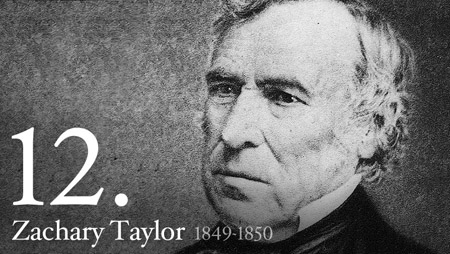
Zachary Taylor, the 12th President of the United States, served from March 4, 1849, until his untimely death on July 9, 1850. Despite his short tenure, Taylor’s presidency was marked by significant events and controversies that reflected the growing tensions in the nation. This article provides an in-depth timeline of Taylor’s presidency, highlighting key dates and events that defined his time in office.
Inauguration and Early Months: March 1849
- March 4, 1849: Zachary Taylor is inaugurated as the 12th President of the United States. Taylor, a hero of the Mexican-American War, enters office with little political experience. His inaugural address emphasizes his commitment to preserving the Union and upholding the Constitution.
- March 5, 1849: Taylor’s first full day in office sees him meeting with his cabinet and setting the stage for his administration. His cabinet includes notable figures such as John M. Clayton as Secretary of State and William M. Meredith as Secretary of the Treasury.
The Issue of Slavery and Territorial Expansion: 1849
- May 1849: California’s Gold Rush leads to a massive influx of settlers, creating pressure for California’s admission to the Union. The question of whether California should enter as a free or slave state becomes a contentious issue.
- July 1849: Taylor recommends that California and New Mexico bypass the territorial stage and apply for statehood directly. This move aims to avoid the heated debate over the extension of slavery into these territories.
The Growing Sectional Divide: Late 1849
- October 1849: California adopts a constitution that prohibits slavery and applies for admission to the Union as a free state. This intensifies the conflict between free and slave states, with Southern politicians threatening secession if California is admitted as a free state.
- November 1849: Taylor reaffirms his support for California’s admission as a free state, stating that he will use force if necessary to preserve the Union. His strong stance against the expansion of slavery earns him the enmity of Southern leaders.
The Crisis Deepens: Early 1850
- January 29, 1850: Senator Henry Clay proposes the Compromise of 1850, a series of measures intended to resolve the territorial and slavery controversies. The compromise includes the admission of California as a free state, the creation of territorial governments for New Mexico and Utah without restrictions on slavery, the abolition of the slave trade in Washington D.C., and the enactment of a stricter Fugitive Slave Law.
- February 1850: Taylor opposes the Compromise of 1850, believing it to be unnecessary. He advocates for the immediate admission of California and New Mexico as free states and rejects any concessions to the South.
Tensions and Political Maneuvering: Spring 1850
- March 4, 1850: Taylor marks his first year in office amid growing tensions. He remains steadfast in his opposition to the expansion of slavery and the Compromise of 1850.
- April 1850: Taylor faces increasing pressure from both Northern and Southern factions. His refusal to support the compromise exacerbates sectional tensions and leads to speculation about a potential civil war.
The Final Months: May – July 1850
- May 1850: Taylor’s health begins to decline, though he continues to perform his presidential duties. He attends various public events and meetings despite feeling unwell.
- July 4, 1850: Taylor participates in Independence Day celebrations in Washington D.C. He reportedly consumes a large quantity of raw fruit and iced milk, which may have contributed to his subsequent illness.
- July 5, 1850: Taylor falls seriously ill with severe gastrointestinal distress. His condition deteriorates rapidly, and he is diagnosed with acute gastroenteritis.
- July 9, 1850: Zachary Taylor dies, just 16 months into his presidency. His sudden death shocks the nation and leaves many questions unanswered about the future of the Union.
Aftermath and Legacy
- July 10, 1850: Vice President Millard Fillmore is sworn in as the 13th President of the United States. Fillmore eventually supports the Compromise of 1850, which passes later that year and temporarily eases sectional tensions.
Legacy and Impact
Zachary Taylor’s presidency, though brief, had significant implications for the nation:
- Staunch Unionism: Taylor’s unwavering commitment to preserving the Union and his opposition to the expansion of slavery into new territories set a precedent for future leaders.
- Compromise of 1850: While Taylor opposed the compromise, his death allowed Fillmore to push it through Congress. The compromise temporarily calmed sectional tensions but ultimately postponed the inevitable conflict over slavery.
- Military Leadership: Taylor’s background as a military leader influenced his approach to governance. His decisive and uncompromising style reflected his battlefield experience but also contributed to political polarization.
Conclusion
Zachary Taylor’s presidency, though cut short, was a critical period in American history. His firm stance against the expansion of slavery and his commitment to the Union highlighted the growing divide within the nation. While his tenure was marked by significant challenges and controversies, Taylor’s legacy endures as a symbol of steadfast leadership during a tumultuous era. His presidency underscored the complexities of the slavery issue and set the stage for the eventual conflict that would culminate in the Civil War.